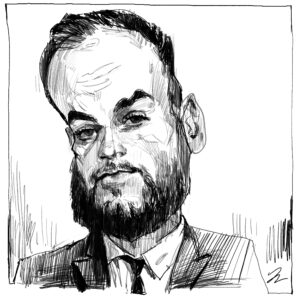Statue of limitations
Why I’m glad to see the back of Alison Lapper Pregnant, a colossal statue that embodied the new British elite’s contempt for the public.

Want to read spiked ad-free? Become a spiked supporter.
Alison Lapper Pregnant has finally been carted away from the fourth plinth in Trafalgar Square. And as far as I’m concerned, it hasn’t come a moment too soon.
The sculpture, by Marc Quinn, which shows the disabled artist Alison Lapper naked and eight months pregnant, was installed in September 2005. Carved from 13 tonnes of white Carrara marble and standing 12ft high, it stared imperiously at the tourists and pedestrians walking through the square and milling around the entrance to the National Gallery. It was removed at the end of last week, and replaced by Thomas Schütte’s Hotel for the Birds, which at least has the virtue of being quite colourful.
Over the past year-and-a-half, on the numerous occasions I walked through Trafalgar Square or passed it by bus, I grew to loathe the Alison Lapper Pregnant statue (not Alison Lapper herself, please note, who I’m sure has overcome great challenges to become both an artist and a mother). The statue captured much of what is rotten in the heart of new Britain. When it was first unveiled, some art critics gushed about how it would challenge people’s perceptions. ‘Against a sky the colour of old underwear, and a circle of buildings that might as well be built of concrete for all the life and warmth their stony facades exude, Quinn’s womanly but warrior-like Lapper [glows] like a beacon’, said one overexcited observer.
In truth, Alison Lapper Pregnant was about as challenging as old underwear. It was a drab monument to the backward pieties of our age. It showed that we value people for what they are rather than what they achieve. In our era of the politics of identity we seem more interested in celebrating individuals’ fixed and quite accidental attributes – their ethnicity, cultural heritage or in Lapper’s case, her disability – rather than what they have discovered or done in the world outside of their bodies. We prefer victims to heroes.
The other three plinths in Trafalgar Square, and of course Nelson’s column in the middle, hold statues that commemorate individuals who did important things: there’s George IV, who was king of Britain and Ireland from 1820 to 1830; Major-General Sir Henry Havelock, best known for capturing Cawnpore from rebels during the Indian Mutiny of 1857; and General Sir Charles James Napier, who was commander-in-chief in India in the 1840s. What you think of these men’s contributions to British history is not important right now; they are at least recognised for things that they did. By contrast, the statue of Lapper on the fourth plinth was a 13-tonne celebration of the distortion wrought by nature on a woman’s body rather than of that woman’s contributions to public life and society.
Alison Lapper Pregnant celebrated what nature, in all its arbitrariness, does to humans rather than what we do to shape, lead and transform the world around us. In this sense, it captured the deeply conservative nature of the identity agenda. The politics of identity privileges fate over self-made destiny. In all the talk of black, Muslim, gay or disabled ‘identity’ – categories created and sustained by the authorities to describe sections of the population who apparently have special needs and desires – we can glimpse the reintroduction of fate into public life, where individuals’ fortunes are seen as being determined by their skin colour or physical afflictions or cultural background rather than by the choices they make and actions they take.
The Lapper statue’s acceptance of fate was clear in the way it clashed with the other monuments in Trafalgar Square. The military men commemorated on the other plinths are shown in military garb and on horseback; they’re depicted in their public roles. Lapper, by contrast, was shown naked, so that those who did not know who she is (and let’s face it, she is not a very famous artist) were likely only to think: ‘Oh look, there’s a disabled woman.’ Where the three military statues commemorate individuals who transformed themselves in the name of achieving some higher purpose, the Lapper statue celebrated one woman’s distorted physicality; where the military statues show men who shaped their own and others’ destinies, the Lapper statue drew the eye towards a naked body shaped by the congenital disorder, phocomelia.
Ironically, this means that Alison Lapper Pregnant was during its tenure the haughtiest and most elitist statue in Trafalgar Square. For all the claims that Marc Quinn had introduced ‘reality’ into a square dominated by stuffy dead imperialists, in fact Lapper assumed her place on the fourth plinth largely through an accident of birth. It was not her contributions to art or public life that were celebrated in Alison Lapper Pregnant, despite what the statue’s supporters claimed, but rather the naked body bestowed on her by nature and birth. Her statue had more in common with that of George IV – who also ended up in Trafalgar Square thanks to an accident of birth: being born into royalty – than many would like to admit.
At the same time, Alison Lapper Pregnant was profoundly patronising to disabled people. Lapper herself has said: ‘The sculpture makes the ultimate statement about disability – that it can be as beautiful and valid a form of being as any other.’ Is that really the ‘ultimate statement’ on disability – that it is ‘valid’? The most common definition of valid is something that is ‘useable or acceptable until a fixed expiration date or under specific conditions of use’. What happened to the idea that we should see disabled people as equal members of society? Alison Lapper Pregnant took us back to the days when disabled people were something to gawp at and gossip about; it was a more sophisticated version of those old Spastics Society collection boxes outside corner shops that depicted sad little girls and boys with bad legs.
The final irritating thing about Alison Lapper Pregnant was the justification put forward by the authorities for erecting it: namely that it would help to ‘challenge people’s perceptions’ and ‘provoke’ us into rethinking disability. In the past, public art was generally born out of public consensus: only when there was a palpable sense that a person had achieved widespread respect would a statue be commissioned in his or her honour. Now, under Mayor Ken Livingstone and the Fourth Plinth organisation, it seems the aim of public art is to hector the public, and help us to snap out of our apparently prejudiced views. It is difficult to avoid the conclusion that Alison Lapper Pregnant was a two-fingered salute by the political and cultural elite to the rest of us.
All of this goes some way to explaining why the statue was such a huge Greek-style monument. Where the military statues in Trafalgar Square are in fact quite modest, the Lapper statue was big and oppressive, a god-like figure surveying the masses that pass through Trafalgar Square. It perfectly embodied the new elite’s contempt for the public. And I for one won’t miss it.
Brendan O’Neill is editor of spiked. Visit his website here. This article was first published on Comment Is Free in May 2007.
James Heartfield said that while Marc Quinn’s sculpture of Alison Lapper put disability on a pedestal, it was not controversial. Josie Appleton decried the return of ‘statuemania’ and art for inclusion’s sake. Patrick West said Alison Lapper deserves admiration, but asked why we should idolise somebody for having an imperfect appearance. Or read more at spiked issue Arts and entertainment.
Celebrate 25 years of spiked!
A media ecosystem dominated by a handful of billionaire owners, bad actors spreading disinformation online and the rich and powerful trying to stop us publishing stories. But we have you on our side. help to fund our journalism and those who choose All-access digital enjoy exclusive extras:
- Unlimited articles in our app and ad-free reading on all devices
- Exclusive newsletter and far fewer asks for support
- Full access to the Guardian Feast app
If you can, please support us on a monthly basis and make a big impact in support of open, independent journalism. Thank you.







Comments
Want to join the conversation?
Only spiked supporters and patrons, who donate regularly to us, can comment on our articles.